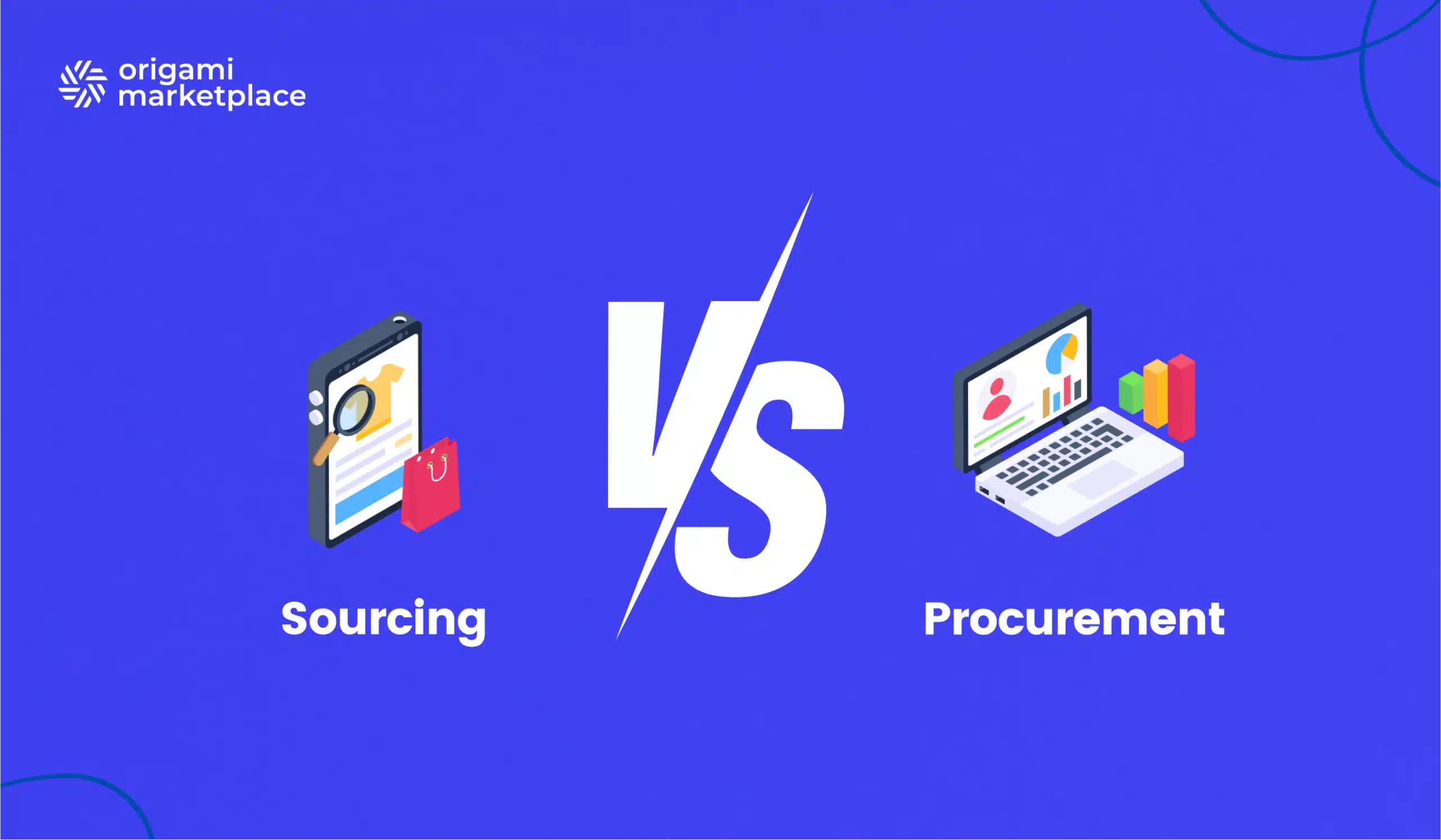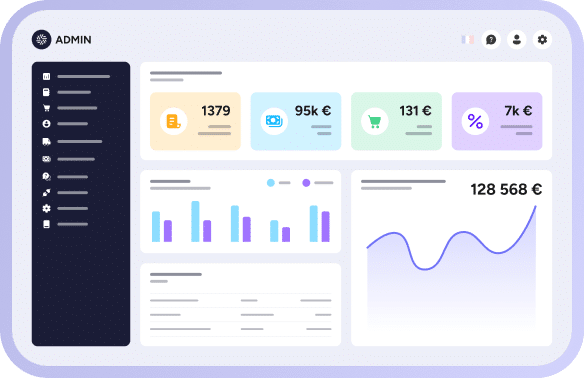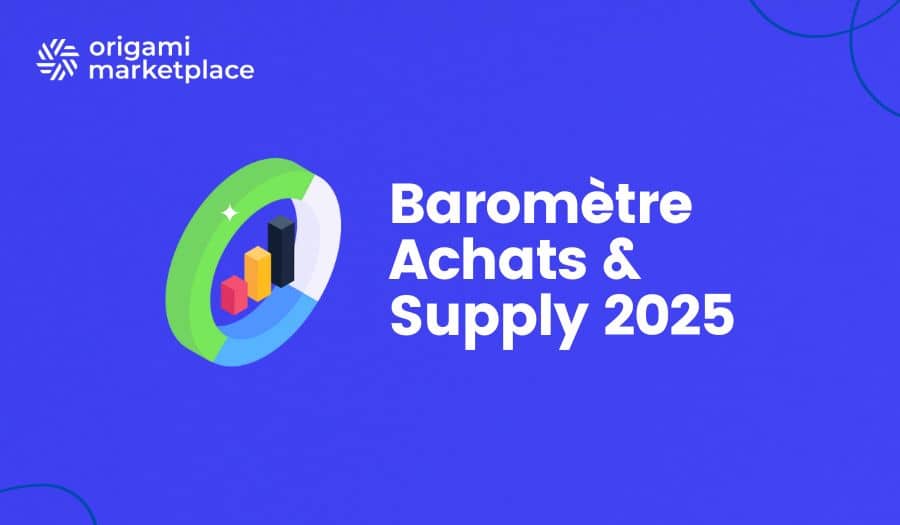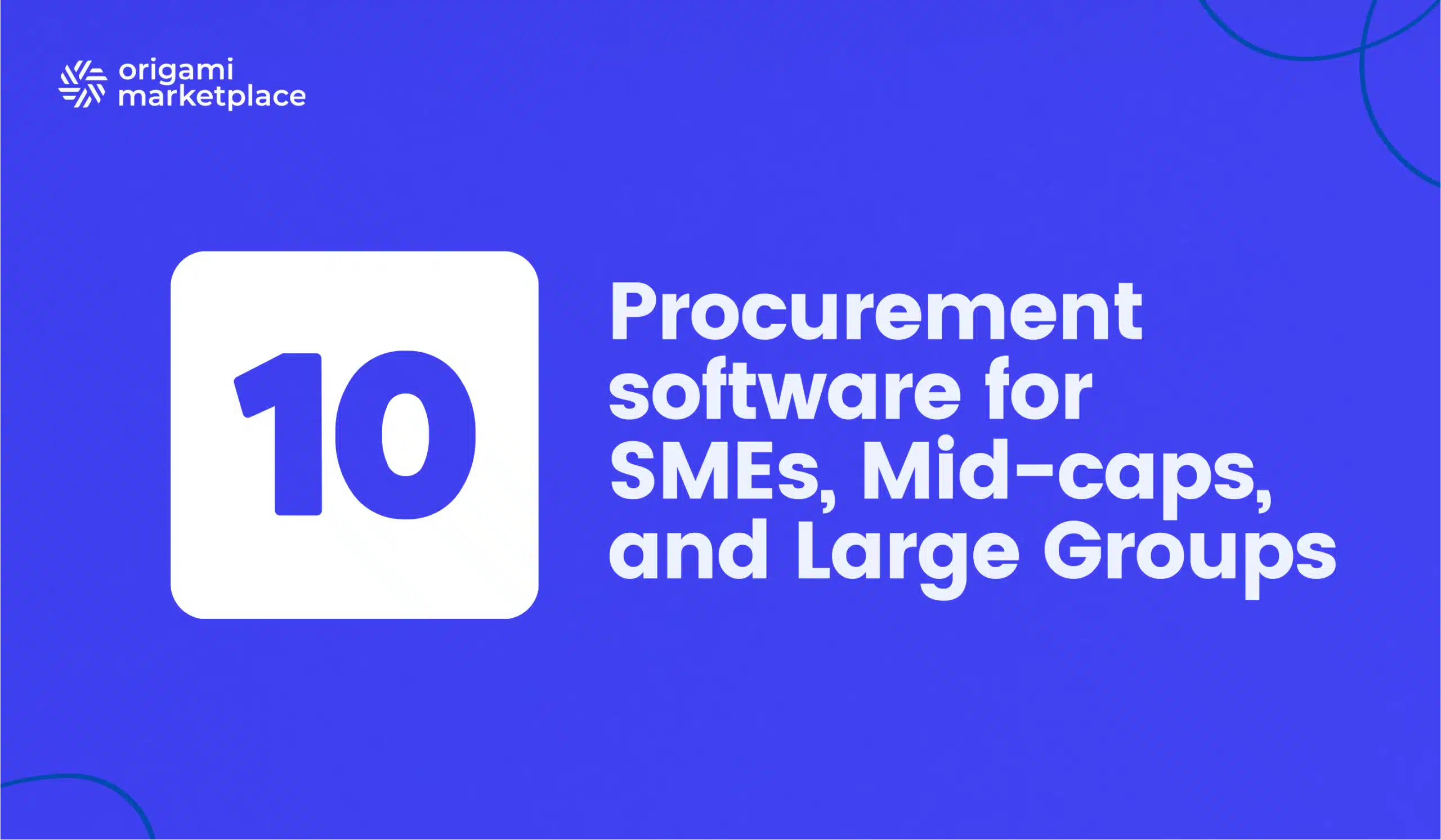Sourcing vs. Procurement: Optimize your purchasing strategy 💶
- Arnaud
- 7 minutes reading

In the complex and ever-evolving world of procurement management, two terms often come up: sourcing and procurement. While frequently used interchangeably, they refer to distinct yet complementary functions within an organization’s supply chain. Understanding the fundamental differences between these two concepts is not only crucial for optimizing purchasing operations, but also for positioning procurement as a genuine lever for performance and innovation.
This article, tailored for procurement professionals, aims to clarify the distinction between sourcing and procurement. We’ll explore their respective definitions, objectives, benefits, and challenges. We’ll highlight how their interdependence drives supply chain resilience, profitability, and compliance. Finally, we’ll examine the impact of new technologies and how solutions like Origami Marketplace can transform these processes into a true strategic advantage.
- Definitions: Sourcing vs Procurement
- Sourcing: The art of strategy and supplier discovery
- Procurement: Precision in execution and daily operations
- Sourcing vs Procurement: A vital partnership
- Benefits & challenges of Sourcing and Procurement
- Key Stats & Insights (2024–2025)
- The role of technology: Toward smarter, frictionless Procurement
- Mastering Sourcing and Procurement for a resilient supply chain
👋 No time to read the whole article? Find the article summary here.
1. Definitions: Sourcing vs Procurement
Sourcing (Strategic Sourcing): Sourcing is the process of identifying, evaluating, and selecting suppliers to acquire goods, services, or raw materials required by an organization. As a strategic function, sourcing focuses on long-term supplier relationships, cost optimization, and quality assurance.
Procurement (Operational Purchasing): Procurement covers the end-to-end process of acquiring goods or services from external sources. This includes identifying needs, sourcing, negotiating, purchasing, receiving, invoicing, payments, and managing supplier relationships. Procurement ensures that the business has what it needs to operate efficiently.
2. Sourcing: The art of strategy and supplier discovery
Strategic sourcing goes far beyond supplier lookup it’s a proactive, analytical approach that aligns supplier selection with the company’s strategic and operational objectives. It’s a long-term function focused on value creation and risk mitigation. Key sourcing activities include:
- Needs analysis: In-depth understanding of internal requirements.
- Supplier market analysis: Mapping suppliers, capabilities, innovations, and positioning.
- Supplier qualification: Applying strict criteria (cost, quality, lead time, compliance, sustainability).
- Strategic negotiations: Building long-term contracts and framework agreements.
- Supplier relationship management (SRM): Developing collaborative relationships to foster innovation and mutual performance.
Discover how our multi-vendor procurement solution can turn purchasing into a strategic driver enabling simplified management, real-time visibility, and fast ROI.

3. Procurement: Precision in execution and daily operations
Procurement follows sourcing decisions and focuses on executing transactions and managing day-to-day purchasing tasks. It’s an efficiency-driven function ensuring compliance and operational continuity. Core procurement activities include:
- Purchase order management: Issuing POs, tracking deliveries, handling acknowledgments.
- Inventory control: Balancing product availability and storage costs.
- Logistics & receiving: Coordinating transportation, receiving, and inspection.
- Invoice & payment management: Matching POs with invoices and ensuring timely payments.
- Dispute resolution: Handling issues with orders, deliveries, or quality.
- Supplier performance tracking: Monitoring compliance with contractual terms.
4. Sourcing vs Procurement: A vital partnership
Though distinct, sourcing and procurement are fundamentally interconnected. Sourcing sets the strategic framework identifying optimal suppliers and negotiating terms while procurement executes these decisions in daily operations. Without effective sourcing, procurement may rely on suboptimal suppliers, increasing costs and risk. Conversely, strategic sourcing is ineffective without disciplined procurement execution.
Together, they form a virtuous cycle:
- Sourcing defines: What to buy, from whom, and under which conditions.
- Procurement manages: How and when to buy.
This synergy is essential to:
- Maximize value
- Ensure operational continuity
- Manage supplier and supply chain risks
- Drive innovation through supplier collaboration
5. Benefits & challenges of Sourcing and Procurement
✅ Key benefits of Sourcing
- Cost optimization: Strategic supplier selection and negotiation deliver long-term savings.
- Risk mitigation: Diversifying suppliers and proactively managing supply risks increases resilience.
- Quality improvement: Choosing reliable suppliers ensures higher standards.
- Innovation access: Enables adoption of new technologies or products via supplier partnerships.
- Sustainability & CSR: Enforces ethical standards and improves brand image.
⚠️ Sourcing challenges
- Market complexity: Global sourcing is time-consuming and resource-intensive.
- Relationship management: Requires dedicated skills and resources.
- Price volatility: Makes long-term contracting more difficult.
- Regulatory compliance: Monitoring supplier compliance across regions is demanding.
✅ Key benefits of Procurement
- Operational efficiency: Streamlined procurement avoids delays and stockouts.
- Spend control: Ensures budget adherence and expense visibility.
- Internal compliance: Aligns with company policies and approval workflows.
- Risk management: Minimizes risks in transactions, delivery, and payments.
⚠️ Procurement challenges
- Lack of automation: Manual processes are error-prone and slow.
- Limited visibility: Hinders strategic decision-making.
- Exception handling: Requires rapid problem resolution.
- User adoption: Intuitive tools are needed to ensure process adherence.
6. Key Stats & Insights (2024–2025)
Here are a few recent statistics highlighting the importance and evolution of sourcing and procurement:
- Cost savings: According to The Hackett Group, generative AI can cut procurement costs by up to 47%.
- AI in contracts: 50% of organizations use AI-driven tools for supplier contract negotiation and risk analysis.
- AI adoption: 28% of procurement teams have launched generative AI pilots.
- Spend analytics: 56% of firms are scaling spend analytics platforms.
- PO compliance: Automation has pushed PO compliance rates to 92%, improving cost control and efficiency.
- CPO priorities: 56% of procurement leaders cite strategic sourcing and spend optimization as top priorities.
- Supplier communication: 98% of suppliers seek better communication from key clients.
- Sustainable procurement: 51% of companies track sustainability metrics at the executive level.
Adopt an innovative multi-vendor purchasing solution that integrates seamlessly with your existing systems. Benefit from an intuitive interface, automation of repetitive tasks and enhanced collaboration with your suppliers.

7. The role of technology: Toward smarter, frictionless Procurement
Digital transformation has revolutionized sourcing and procurement. Tools like eProcurement platforms, analytics, AI, and automation unlock massive opportunities to streamline processes:
- Task automation: Reduces errors and frees teams for high-value work.
- Visibility: Provides a comprehensive view of spend, supplier performance, and risk.
- Collaboration: Facilitates smoother interactions with suppliers and stakeholders.
- Data-driven decisions: Enables predictive insights and demand forecasting.
AI delivers quick wins on data and processes, but only when built on a unified technology foundation.
Goodbye fragmented tools. Hello ROI
AI only reaches its full potential when your data and processes are unified. That’s where B2B multi-vendor platforms like Origami Marketplace come in:
- All-in-one, no hidden costs: Sourcing, purchasing, invoicing, and reporting on one modular platform.
- 24h supplier onboarding: Native connectors (PrestaShop, Magento, Shopify, flat files, APIs) simplify onboarding no heavy IT lift.
- Fully automated workflows: Approval and payment circuits that slash procurement cycle times.
- Single cart, multi-supplier orders: Simplified for buyers, traceable for finance.
- API-first architecture: Easily connects with ERP systems (SAP, Oracle, Dynamics, Sage, etc.) complements your ERP instead of replacing it.
Result? ROI within 3 months via lower direct costs (pricing, supplier diversification) and indirect costs (processing time, system maintenance).
Why combine AI + Marketplace?
- Clean, centralized data: The marketplace becomes AI’s single source of truth.
- End-to-end automation: AI makes the decision, the platform executes.
- Scalability: New suppliers or savings opportunities are onboarded in 24 hours, not 6 weeks.
Let AI steer the strategy, and let a multi-vendor marketplace handle execution and data flows. Together, they turn sourcing and procurement into a measurable competitive advantage.
Keep AI for strategy and decision-making, entrust execution and centralized flows to an API-first multi-vendor marketplace. Together, they transform sourcing and procurement into a measurable competitive advantage.

Alexandre Duquenoy
→ Talk to our expert
8. Mastering Sourcing and Procurement for a resilient supply chain
Though different in nature, sourcing and procurement are two inseparable pillars of procurement excellence. Sourcing lays the strategic foundation by identifying and securing the best sources. Procurement ensures its day-to-day implementation with operational rigor.
For procurement leaders, mastering both disciplines is essential to navigate increasing complexity and uncertainty. With an integrated approach and the right technology, organizations can not only reduce costs and optimize processes, but also build a more resilient, agile, and innovative supply chain.
Investing in smart tools and upskilling teams across both areas is key to turning procurement into a true competitive edge.
In a nutshell: What Procurement leaders should remember
- Sourcing = Strategy. Identify, assess, and engage top-tier suppliers for long-term value.
- Procurement = Execution. Manage daily transactions to ensure efficiency and compliance.
- Complementarity: Sourcing sets the framework; procurement brings it to life. Both are essential.
- Technology: Tools like AI and platforms such as Origami Marketplace are reshaping the future of procurement.
👉 Need a turnkey solution? Call on a specialized service provider like Origami Marketplace to accelerate your project. Discover how our API and partner network can transform your business, whatever its size, thanks to its innovative solution based on the marketplace model.


